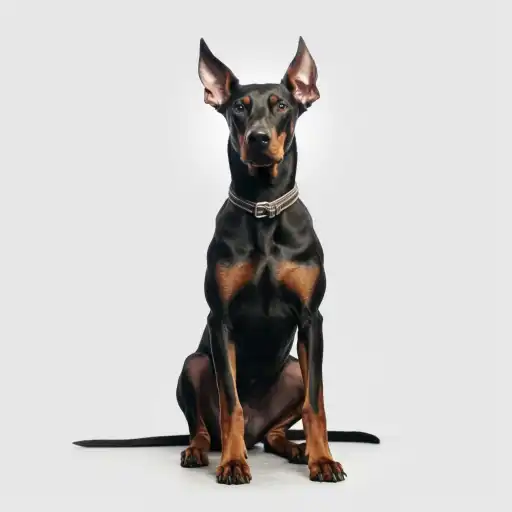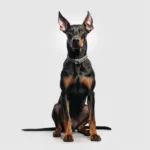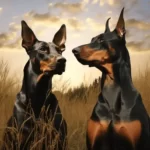When delving into the world of Doberman Pinschers, you may come across the term “Warlock Doberman.” However, it is crucial to understand that the term “Warlock” is not recognized or utilized within reputable breed standards or official Doberman Pinscher organizations. Let’s explore the distinction between a Warlock Doberman and a standard Doberman Pinscher to shed light on this often misunderstood topic.
The term “Warlock” is essentially a marketing term used by certain breeders to describe Doberman Pinschers that are bred to be larger, heavier, or more massive than the standard size outlined by breed standards. These dogs may possess exaggerated features, such as a larger head or a heavier bone structure. However, it is important to approach such terminology with caution and discernment, as it does not represent a separate or distinct type of Doberman.
In contrast, the Doberman Pinscher, also known simply as the Doberman, is a medium-sized, athletic, and elegant breed that has gained popularity worldwide. It is recognized and standardized by kennel clubs and breed organizations globally. The Doberman is revered for its distinctive wedge-shaped head, alert expression, and an overall appearance that exudes strength, agility, and endurance.
To better understand the differences, let’s examine the characteristics of both the Warlock Doberman (as it is referred to) and the Doberman Pinscher recognized by official breed standards.
Unraveling the Origin: Warlock Doberman and its Legacy
The term “Warlock Doberman” has perplexed and fascinated Doberman enthusiasts for years, but its true origin remains shrouded in mystery. This controversial label, not officially recognized by reputable breed organizations or Doberman Pinscher standards, has garnered attention within certain breeder circles. Let’s delve deeper into the enigmatic history of the “Warlock Doberman” and unravel the truths behind this debated term.
The exact origin of the term “Warlock Doberman” is elusive, as it emerged within specific breeder networks rather than being established by recognized Doberman organizations. It gained traction among breeders seeking to distinguish their breeding programs by selectively producing Dobermans that deviate from the standard size and characteristics outlined by breed standards. However, it is essential to note that the term lacks recognition and legitimacy within the wider Doberman community.
The allure of the “Warlock Doberman” lies in its association with Dobermans bred for extreme size or exaggerated features. Some breeders sought to create a niche market by selectively breeding larger Dobermans with heavier bone structures and more massive heads. These Dobermans were often marketed as Warlock Dobermans to pique the interest of potential buyers looking for something outside the bounds of traditional breed standards.
Despite the allure, concerns have been raised about the breeding practices associated with the term “Warlock Doberman.” Breeding for extreme size can lead to various health issues, including skeletal problems, joint dysplasia, and increased susceptibility to conditions such as hip dysplasia or cardiomyopathy. Responsible breeders prioritize the overall health and well-being of the breed, adhering to breed standards that define the characteristics and temperament of a Doberman Pinscher.
Respected Doberman breed organizations and breeders do not endorse the use of the term “Warlock” due to its lack of recognition within official breed standards. Instead, they focus on maintaining the breed’s original purpose, health, and temperament, following strict guidelines outlined by reputable kennel clubs and breed organizations.
It is crucial for potential Doberman owners to exercise caution when encountering the term “Warlock Doberman.” Emphasis should be placed on finding a responsible breeder who prioritizes the breed’s well-being, adheres to recognized breed standards, and conducts genetic health testing to ensure the production of healthy and well-rounded Doberman Pinschers.
By partnering with an ethical and knowledgeable breeder, prospective owners can avoid the pitfalls associated with the “Warlock” label and acquire a Doberman Pinscher that embodies the breed’s true spirit. Responsible breeders prioritize the breed’s overall health, temperament, agility, and adherence to recognized breed standards—factors that contribute to a Doberman’s longevity and its ability to fulfill the breed’s inherent qualities.
The Doberman Pinscher
The Doberman Pinscher, as recognized by reputable kennel clubs and breed organizations, is an elegant and well-proportioned breed that embodies both grace and power. Its sleek and muscular build is a testament to its agility and athleticism. Official breed standards outline specific criteria for size, appearance, and temperament, serving as a guide for responsible breeders and enthusiasts.
A standard Doberman Pinscher is a medium-sized dog with a height range typically falling between 24 to 28 inches at the shoulder for males and 22 to 26 inches for females. Weight can vary, but it generally falls between 60 to 90 pounds for males and 50 to 70 pounds for females.
The breed’s defining features include a distinct wedge-shaped head with a well-defined stop, which is the indentation or angle between the forehead and the muzzle. The head should have a proportionate and balanced appearance, complementing the dog’s overall structure. The Doberman’s eyes are usually dark and almond-shaped, exuding a vigilant and intelligent expression.
Doberman Pinschers are admired for their exceptional athleticism, agility, and versatility. They possess an alert and determined temperament, making them excellent candidates for various tasks and activities. When properly bred and trained, Dobermans display traits such as loyalty, intelligence, and a strong desire to please their owners.
Responsible Breeding and Ethical Considerations
It is essential to approach the topic of Warlock Dobermans with care and skepticism. Breeders who promote Warlock Dobermans or focus on breeding for extreme size may not adhere to responsible breeding practices or prioritize the well-being of the breed. Conscientious breeders prioritize health, temperament, adherence to breed standards, and the preservation of the Doberman’s natural abilities.
Responsible Doberman breeders prioritize the overall health and longevity of the breed. They conduct health screenings to detect potential hereditary conditions and aim to produce well-rounded Dobermans that conform to the established breed standards. By following these practices, responsible breeders contribute to the preservation and betterment of the breed, ensuring that future generations of Dobermans embody the breed’s essential qualities.
Potential Doberman owners and enthusiasts should exercise caution when encountering breeders promoting Warlock Dobermans or emphasizing extreme size. It is advisable to research and identify breeders who demonstrate a commitment to the breed’s well-being, health testing, ethical breeding practices, and adherence to breed standards recognized by reputable kennel clubs and breed organizations.
In Conclusion
Understanding the distinction between the term “Warlock Doberman” and the standard Doberman Pinscher is crucial for anyone interested in this magnificent breed. The Doberman Pinscher, recognized by established breed organizations, embodies a balanced combination of athleticism, intelligence, and loyalty.
While the term “Warlock” may be used to describe oversized Doberman Pinschers bred for extreme size and exaggerated features, it is not recognized by reputable breed organizations and is associated with concerns regarding health and adherence to breed standards.
When considering adding a Doberman to your family, prioritize responsible breeders who demonstrate a commitment to the breed’s health, temperament, and the preservation of the Doberman Pinscher’s characteristics. By doing so, you ensure that your Doberman is a true representation of the breed’s noble heritage and stands as a testament to the remarkable qualities that have made this breed beloved by enthusiasts around the world.


